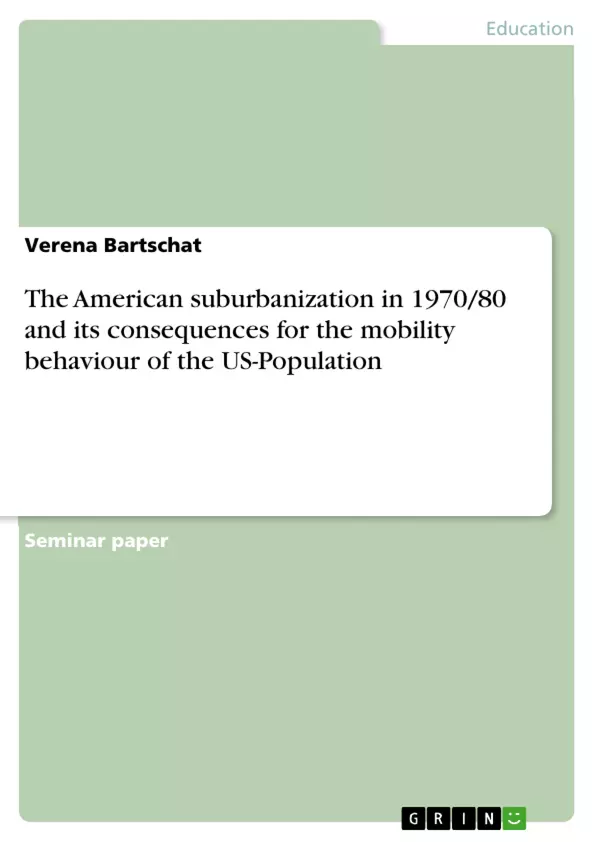This paper is on suburbanization and the resulting mobility behavior of the US-population. In
the first passage, the term “suburbanization” will be explained as well as the corresponding
reasons and consequences.
In the following, the mobility behavior which is highly shaped by suburbanization will be illustrated.
Thereby, the actions of some American cities to speed up the reurbanization, using
projects concerning the local public transport, and to improve the housing situation in the
long run will be examined. Furthermore, the fight against the reasons for the suburbanization,
with the integration of ethnic minorities leading the way, will be thematized. This process will
be explained in chapter four.
The topic is still of current interest: cities and communities, but also the whole population are
forced to change their thinking due to growing demands on the protection of the environment
and species as well as increasing prices for commodities (especially oil in that context). Long
trips to work, in many cases caused by the suburbanization, are no longer affordable. They
demand a high time budget that cannot be brought into accordance with the new trend to an
ecological lifestyle.
Inhaltsverzeichnis (Table of Contents)
- Introduction
- Suburbanization
- Terminology and definitions
- Consequences
- Reasons
- Suburbanization and mobility behaviour
- Countering the causes
- Conclusion
Zielsetzung und Themenschwerpunkte (Objectives and Key Themes)
This paper examines the phenomenon of suburbanization in the United States during the 1970s and 1980s, focusing on its impact on the mobility behavior of the US population. The paper aims to provide a comprehensive understanding of the term "suburbanization," exploring its contributing factors, consequences, and the resulting shifts in mobility patterns. Key themes include:- The definition and historical development of suburbanization in the US context
- The social, economic, and environmental consequences of suburbanization
- The relationship between suburbanization and changes in mobility patterns, such as increased car dependence and longer commutes
- Efforts to mitigate the negative consequences of suburbanization, including reurbanization initiatives and strategies to improve public transportation
- The influence of suburbanization on social integration and the formation of ethnic enclaves
Zusammenfassung der Kapitel (Chapter Summaries)
Introduction
This introductory chapter sets the stage for the paper by defining the scope of the study, which focuses on suburbanization and its impact on the mobility behavior of the US population. It highlights the paper's main objectives and themes, including the exploration of the term "suburbanization," its driving forces, consequences, and the resulting changes in transportation patterns.Suburbanization
This chapter delves deeper into the concept of suburbanization. It starts by defining the term and its various manifestations, drawing attention to its prominence in the United States compared to other parts of the world. The chapter further explores the consequences of suburbanization, including fiscal impacts on cities, the emergence of slums, and increased reliance on private vehicles, leading to longer commutes and environmental concerns. The chapter concludes by examining the key factors driving suburbanization, highlighting the role of industrialization, wealth accumulation, and the historical influx of immigrants to the US.Suburbanization and mobility behaviour
This chapter will likely analyze the direct impact of suburbanization on the mobility patterns of the US population. It may explore how suburban development leads to increased car dependence, longer commutes, and reduced reliance on public transportation. The chapter might also discuss the implications of these changes for individual travel time budgets, environmental pollution, and the overall sustainability of urban areas.Countering the causes
This chapter will likely focus on efforts to address the causes and consequences of suburbanization. It may examine initiatives aimed at promoting reurbanization, improving public transportation systems, and addressing the housing needs of diverse populations. The chapter may also discuss the role of social integration in combating the formation of ethnic enclaves and promoting a more inclusive urban landscape.Schlüsselwörter (Keywords)
The key concepts explored in this paper include suburbanization, reurbanization, mobility behavior, transportation patterns, urban development, environmental impacts, social integration, and ethnic diversity. The paper aims to provide a comprehensive understanding of the complex relationship between suburbanization and mobility patterns in the United States, examining its historical roots, consequences, and potential solutions.- Quote paper
- Verena Bartschat (Author), 2013, The American suburbanization in 1970/80 and its consequences for the mobility behaviour of the US-Population, Munich, GRIN Verlag, https://www.grin.com/document/267054



